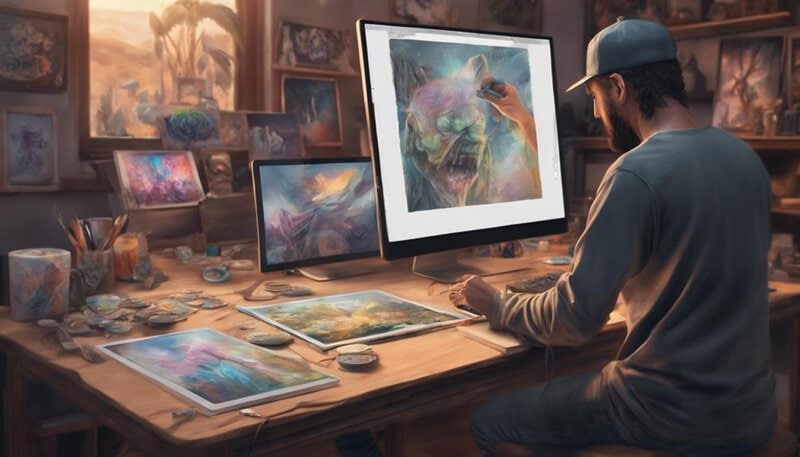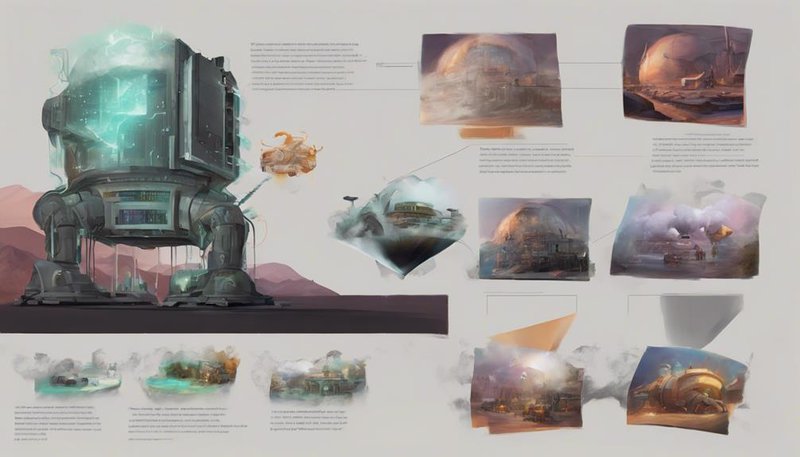What Is Minting in Nfts? Process Explained With Real Examples

Minting in NFTs is the process of creating a unique digital token that represents ownership of a digital asset, such as artwork or music. It involves using blockchain technology to verify the authenticity and scarcity of the asset.
Minting NFTs allows creators to tokenize their work and sell it as a collectible item on various NFT marketplaces.
Minting in NFTs: An Overview
To delve into the intricacies of minting in NFTs, one must first grasp the fundamental concept of creating these unique digital assets. Minting tokens involves the process of turning a digital asset into a one-of-a-kind, verifiable item on the blockchain. These digital assets, whether they be art, music, videos, or any other form of creative work, are tokenized to ensure their scarcity and authenticity. By minting tokens, creators establish ownership and provenance in the digital realm, akin to traditional certificates of authenticity for physical artworks.
Understanding the significance of minting digital assets is paramount in the world of NFTs. It allows creators to imbue their works with value and uniqueness, opening up new possibilities for ownership and monetization. Each minted token represents a singular piece that can't be replicated or forged, providing both artists and collectors with a secure and transparent way to engage in the digital art market. Embracing the concept of minting is the cornerstone of the NFT ecosystem, where innovation and creativity converge to redefine ownership in the digital age.
Understanding NFT Minting Process
Delve into the intricate process of understanding NFT minting, a pivotal aspect of the digital art world that bestows uniqueness and value upon creative works. When it comes to NFT creation, the tokenization process is a crucial step that transforms digital assets into one-of-a-kind tokens.
- Artwork Digitization: NFT minting initiates with the conversion of physical or digital art pieces into a digital format that can be tokenized.
- Metadata Inclusion: The tokenization process involves adding metadata such as the artist's name, creation date, and a description to provide context and provenance for the NFT.
- Smart Contract Integration: Smart contracts play a vital role in the minting process by automating the verification and transfer of ownership for NFTs.
- Blockchain Confirmation: Once minted, the NFT is verified and recorded on a blockchain, ensuring transparency and security in the tokenization process.
Benefits of Minting NFTs

Embark on a journey exploring the manifold benefits that stem from minting NFTs, illuminating the transformative power these unique tokens offer in the realm of digital creativity and ownership.
The minting advantages of NFTs are vast and profound. By minting NFTs, creators can establish undeniable ownership and authenticity over their digital creations, safeguarding them from unauthorized replication or misuse. This not only protects the artist's work but also ensures that they receive rightful recognition and compensation for their efforts.
Furthermore, the benefits of NFT creation extend beyond mere ownership. Minting NFTs opens up new avenues for artists to connect with their audience on a deeper level, fostering a sense of community and appreciation for their craft. Additionally, the decentralized nature of NFTs allows for borderless transactions, enabling artists to reach a global audience without the constraints of traditional marketplaces.
In essence, the act of minting NFTs not only empowers creators but also revolutionizes the way we perceive and interact with digital art, ushering in a new era of creative expression and ownership.
How to Mint NFTs Step by Step
Beginning the journey to mint NFTs requires a clear understanding of the step-by-step process involved in creating these unique digital assets. To guide you through this transformative experience, consider the following step-by-step guide:
- Select a Minting Platform: Research and choose a minting platform that aligns with your goals and values. Popular platforms include OpenSea, Rarible, and Mintable.
- Create a Digital Wallet: Set up a digital wallet compatible with the chosen minting platform to store your NFTs securely.
- Prepare Your Artwork: Ensure your digital artwork meets the platform's specifications for file type, size, and quality to optimize the minting process.
- Mint Your NFT: Follow the platform's guidelines to mint your NFT, including setting royalties, creating a description, and determining the number of copies to mint.
Real-World Examples of NFT Minting

Exploring the realm of NFT minting reveals a diverse array of real-world examples that showcase the innovative possibilities within this burgeoning digital landscape. Artists, musicians, and creators worldwide have been utilizing NFT creation to revolutionize the way they monetize and distribute their work. One notable example is the artist Beeple, who sold an NFT artwork for $69 million, highlighting the immense value that can be generated through this process.
To further illustrate the impact of NFT minting, consider the table below, which outlines some key real-world examples and the associated minting fees:
| NFT Project | Type | Minting Fee (USD) |
|---|---|---|
| CryptoPunks | Pixel Art | $100 |
| NBA Top Shot | Sports Highlights | $50 |
| Axie Infinity | Gaming | $30 |
| Rarible | Digital Art | $20 |
| Decentraland | Virtual Real Estate | $15 |
These examples demonstrate the varied nature of NFT projects and the corresponding minting fees involved in bringing these unique digital assets to life.
Factors to Consider When Minting NFTs
As you embark on the journey of minting NFTs, consider the unique attributes that make your creation stand out in the digital realm. Reflect on the scarcity, utility, and authenticity of your NFT, for these factors can greatly impact its value and desirability.
Minting NFTs Considerations
Consider carefully the key factors when minting NFTs to ensure a successful and strategic approach to this digital asset creation process.
- Understand the Minting Process Complexity: Delve into the intricacies of the minting process to grasp its nuances fully.
- Research Various Minting Platform Options: Explore different platforms available for minting NFTs to find one that aligns with your goals.
- Evaluate Gas Fees and Blockchain Sustainability: Assess the associated costs and environmental impact of minting on different blockchain networks.
- Plan for Metadata Storage and Maintenance: Develop a strategy for storing and maintaining metadata associated with your NFTs to ensure their longevity and authenticity.
NFTs Minting Factors
To embark on the journey of minting NFTs successfully, it is imperative to meticulously analyze the key factors that shape this intricate process. When considering minting NFTs, factors such as minting criteria evaluation, minting platform comparison, minting token customization, and minting process automation play crucial roles in determining the outcome of your NFT project. Evaluating these aspects thoughtfully can lead to a more refined and successful minting process. By comparing different minting platforms and customizing your tokens to align with your artistic vision, you enhance the uniqueness and value of your NFTs. Additionally, automating certain aspects of the minting process can save time and streamline your operations, allowing for a more efficient creation process.
| Factors | Description | Importance |
|---|---|---|
| Minting Criteria Evaluation | Critical assessment of minting guidelines | High importance |
| Minting Platform Comparison | Comparing features and fees of different platforms | Essential |
| Minting Token Customization | Tailoring NFTs to reflect your creative vision | Significant |
Minting Costs and Fees Explained

Exploring the world of NFTs entails delving into the intricate realm of minting costs and fees, a pivotal aspect that demands careful consideration. When it comes to minting your own NFTs, understanding the financial implications is crucial. Here are some key points to bear in mind:
- Minting Pricing Breakdown: Before minting an NFT, it's essential to grasp the breakdown of costs involved. This may include platform fees, gas fees, and royalties to creators.
- Minting Transaction Fees: Transaction fees can vary depending on the blockchain network you choose. Ethereum, for instance, often incurs higher gas fees compared to other networks like Tezos or Flow.
- Royalty Fees: Setting up royalty fees ensures that artists receive a percentage of future sales. Consider the long-term benefits of this feature when determining your minting costs.
- Platform-Specific Costs: Different NFT platforms have varying fee structures. Take the time to research and compare platforms to find one that aligns with your budget and goals.
Best Practices for Successful NFT Minting
Navigating the world of NFTs with a keen eye on successful minting requires a strategic approach that encompasses both creativity and foresight. When delving into the realm of token creation, it's essential to meticulously plan every aspect of your NFT project. Begin by conceptualizing a unique and compelling idea that resonates with your audience. Ensure that your digital artwork or collectible is of high quality and aligns with current trends in the NFT market.
Moreover, understanding the concept of digital ownership is crucial. Clearly define the rights and privileges that come with owning your NFT. Consider offering additional perks or benefits to incentivize collectors. Building a strong community around your NFT project can significantly enhance its value and longevity.
Frequently Asked Questions
How Do NFT Minting Platforms Ensure the Authenticity and Uniqueness of Each Token?
To ensure authenticity and uniqueness of each token, NFT minting platforms utilize advanced encryption and verification processes. By incorporating blockchain technology, smart contracts, and digital signatures, these platforms safeguard the integrity and individuality of each NFT.
Are There Any Legal Considerations or Copyright Issues to Be Aware of When Minting Nfts?
When minting NFTs, legal implications and copyright protection are crucial considerations. Ensure you have the right to use the content for commercial purposes. Consulting legal experts can provide guidance on navigating potential copyright issues and safeguarding intellectual property.
Can NFT Minting Be Done Anonymously, or Is Identification Required?
To ensure anonymity when minting an NFT, explore platforms offering anonymity options. Some might require verification for authenticity. Consider the verification process carefully to balance privacy with the platform's requirements and your desired level of anonymity.
Are There Any Restrictions on the Type of Content That Can Be Minted as an Nft?
When considering minting NFTs, bear in mind that legal implications and content guidelines apply. Respect copyright laws and avoid offensive material. Strengthen your understanding of these aspects to ensure ethical and lawful participation in the NFT space.
How Does the Environmental Impact of Minting NFTs Compare to Traditional Art Production Methods?
When considering the environmental impact of minting NFTs versus traditional art production methods, sustainability is crucial. Comparing carbon footprints, NFTs often have a lower impact due to digital nature. Embracing eco-conscious choices can pave the way for more sustainable art practices.








